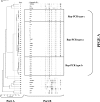Comparative evaluation of an automated repetitive-sequence-based PCR instrument versus pulsed-field gel electrophoresis in the setting of a Serratia marcescens nosocomial infection outbreak
- PMID: 20237095
- PMCID: PMC2863922
- DOI: 10.1128/JCM.01528-09
Comparative evaluation of an automated repetitive-sequence-based PCR instrument versus pulsed-field gel electrophoresis in the setting of a Serratia marcescens nosocomial infection outbreak
Abstract
A semiautomated, repetitive-sequence-based PCR (rep-PCR) instrument (DiversiLab system) was evaluated in comparison with pulsed-field gel electrophoresis (PFGE) to investigate an outbreak of Serratia marcescens infections in a neonatal intensive care unit (NICU). A selection of 36 epidemiologically related and 8 epidemiologically unrelated isolates was analyzed. Among the epidemiologically related isolates, PFGE identified five genetically unrelated patterns. Thirty-two isolates from patients and wet nurses showed the same PFGE profile (pattern A). Genetically unrelated PFGE patterns were found in one patient (pattern B), in two wet nurses (patterns C and D), and in an environmental isolate from the NICU (pattern G). Rep-PCR identified seven different patterns, three of which included the 32 isolates of PFGE type A. One or two band differences in isolates of these three types allowed isolates to be categorized as similar and included in a unique cluster. Isolates of different PFGE types were also of unrelated rep-PCR types. All of the epidemiologically unrelated isolates were of different PFGE and rep-PCR types. The level of discrimination exhibited by rep-PCR with the DiversiLab system allowed us to conclude that this method was able to identify genetic similarity in a spatio-temporal cluster of S. marcescens isolates.
Figures


Similar articles
-
Nosocomial neonatal outbreak of Serratia marcescens--analysis of pathogens by pulsed field gel electrophoresis and polymerase chain reaction.Infection. 2002 Oct;30(5):277-81. doi: 10.1007/s15010-002-2141-y. Infection. 2002. PMID: 12382086
-
Use of pulsed-field gel electrophoresis to investigate an outbreak of Serratia marcescens infection in a neonatal intensive care unit.J Hosp Infect. 2001 May;48(1):13-9. doi: 10.1053/jhin.2001.0947. J Hosp Infect. 2001. PMID: 11358466
-
Using pulsed-field gel electrophoresis in the molecular investigation of an outbreak of Serratia marcescens infection in an intensive care unit.Singapore Med J. 2004 May;45(5):214-8. Singapore Med J. 2004. PMID: 15143356
-
Outbreaks of Serratia marcescens in neonatal and pediatric intensive care units: clinical aspects, risk factors and management.Int J Hyg Environ Health. 2010 Mar;213(2):79-87. doi: 10.1016/j.ijheh.2009.09.003. Epub 2009 Sep 26. Int J Hyg Environ Health. 2010. PMID: 19783209 Review.
-
Serratia marcescens infections and outbreaks in neonatal intensive care units.J Chemother. 2009 Nov;21(5):493-9. doi: 10.1179/joc.2009.21.5.493. J Chemother. 2009. PMID: 19933039 Review.
Cited by
-
Systematic analysis of plasmids of the Serratia marcescens complex using 142 closed genomes.Microb Genom. 2023 Nov;9(11):001135. doi: 10.1099/mgen.0.001135. Microb Genom. 2023. PMID: 37966169 Free PMC article.
-
First Italian outbreak of VIM-producing Serratia marcescens in an adult polyvalent intensive care unit, August-October 2018: A case report and literature review.World J Clin Cases. 2019 Nov 6;7(21):3535-3548. doi: 10.12998/wjcc.v7.i21.3535. World J Clin Cases. 2019. PMID: 31750335 Free PMC article.
-
Human pathogen shown to cause disease in the threatened eklhorn coral Acropora palmata.PLoS One. 2011;6(8):e23468. doi: 10.1371/journal.pone.0023468. Epub 2011 Aug 17. PLoS One. 2011. PMID: 21858132 Free PMC article.
-
Molecular Characterization of Carbapenem-Resistant Serratia marcescens Clinical Isolates in a Tertiary Hospital in Hangzhou, China.Infect Drug Resist. 2020 Apr 7;13:999-1008. doi: 10.2147/IDR.S243197. eCollection 2020. Infect Drug Resist. 2020. PMID: 32308441 Free PMC article.
-
Development of a qPCR assay to identify and differentiate insect-associated strains of the Serratia marcescens complex.J Vet Diagn Invest. 2025 Mar;37(2):234-243. doi: 10.1177/10406387241313448. Epub 2025 Jan 27. J Vet Diagn Invest. 2025. PMID: 39865995 Free PMC article.
References
-
- Cangelosi, G. A., R. J. Freeman, K. N. Lewis, D. Livingston-Rosanoff, K. S. Shah, S. J. Milan, and S. V. Goldberg. 2004. Evaluation of a high-throughput repetitive-sequence-based PCR system for DNA fingerprinting of Mycobacterium tuberculosis and Mycobacterium avium complex strains. J. Clin. Microbiol. 42:2685-2693. - PMC - PubMed
-
- Carretto, E., D. Barbarini, C. Farina, A. Grosini, P. Nicoletti, E. Manso, and the APSI Acinetobacter Study Group, Italy. 2008. Use of DiversiLab semiautomated repetitive-sequence-based polymerase chain reaction for epidemiologic analysis on Acinetobacter baumannii isolates in different Italian hospitals. Diagn. Microbiol. Infect. Dis. 60:1-7. - PubMed
-
- Casolari, C., M. Pecorari, G. Fabio, S. Cattani, C. Venturelli, L. Piccini, M. G. Tamassia, W. Gennari, A. M. Sabbatini, G. Leporati, P. Marchegiano, F. Rumpianesi, and F. Ferrari. 2005. A simultaneous outbreak of Serratia marcescens and Klebsiella pneumoniae in a neonatal intensive care unit. J. Hosp. Infect. 61:312-320. - PubMed
-
- Clinical and Laboratory Standards Institute. 2007. Performance standards for antimicrobial susceptibility testing; 17th informational supplement. M100-S17. Clinical and Laboratory Standards Institute, Wayne, PA.
-
- David, M. D., T. M. Weller, P. Lambert, and A. P. Fraise. 2006. An outbreak of Serratia marcescens on the neonatal unit: a tale of two clones. J. Hosp. Infect. 63:27-33. - PubMed
Publication types
MeSH terms
Substances
LinkOut - more resources
Full Text Sources

